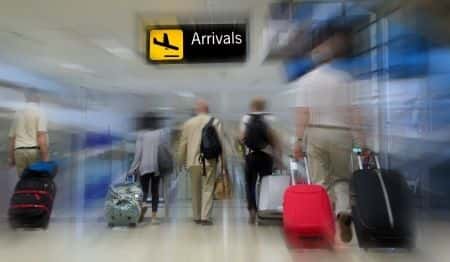This case involves an airline passenger who was attempting to board a 737 jetliner. There were some wet spots of liquid running across the area where the passengers walked in order to board the plane. The passenger walked across this area and up the metal stairway leading to the entrance of the plane. As he stepped across the threshold onto a special vinyl flooring material, his right foot slipped, causing him to fall and severely injured his knee. The passenger fractured his kneecap (the patella) and tore tendons connected to his upper leg (the femur). There was a liquid on the vinyl flooring material and on the passenger’s footwear. The liquid was a de-icing spray that had been sprayed on the aircraft. The water/glycol spray had spread across the loading area where the passenger attempted to board the plan. The front of the aircraft where the passenger entered the plane was thoroughly wet. The passenger sued the airline for negligence and violation of aviation safety regulations.
Question(s) For Expert Witness
1. Can an airline passenger sue an airline for negligence after he slips and falls on airplane de-icing spray?
Expert Witness Response
Airplane de-icing spray is made from an ethylene-glycol fluid that is sprayed on a plane prior to take-off. De-icing fluid is mixed with water to a 50% concentration by volume. The de-icing spray contains numerous wetting agents that help the spread the spray all over the plane’s surfaces. The danger from de-icing spray is that the glycol-based chemicals in the spray are very soluble and usually break down rapidly after being sprayed on a plane. This creates a large run-off which usually has to be diverted into a stormwater discharge system or has to be collected in a separate holding area for later processing. Under the Restatement of Torts (Second) § 283, a common carrier, such as an airplane, owes a special duty to passengers to use the utmost care and diligence for their safe passage. In this case, the airline is probably liable for the passenger’s injuries because they had a duty to make sure that there were no safety hazards for passengers and also to warn passengers if they knew about any hazards. Since the airline could have reasonably foreseen that the de-icing fluid would run all over the loading area, the airline had a duty to warn passengers about the dangerous condition. Since the airline failed to warn passengers about the slipping hazard, they probably were negligent and are liable for the passenger’s knee injury.
About the author
Michael Talve, CEO
Michael Talve stands at the forefront of legal innovation as the CEO and Managing Director of Expert Institute. Under his leadership, the Expert Institute has established itself as a vital player in the legal technology arena, revolutionizing how lawyers connect with world-class experts and access advanced legal technology. Michael's role involves not only steering the company's strategic direction but also ensuring the delivery of unparalleled intelligence and cutting-edge solutions to legal professionals. His work at Expert Institute has been instrumental in enhancing the capabilities of attorneys in case preparation and execution, making a significant impact on the legal industry's approach to expert consultation and technological integration. Michael's vision and execution have positioned the Expert Institute as a key facilitator in the intersection of law and technology.



